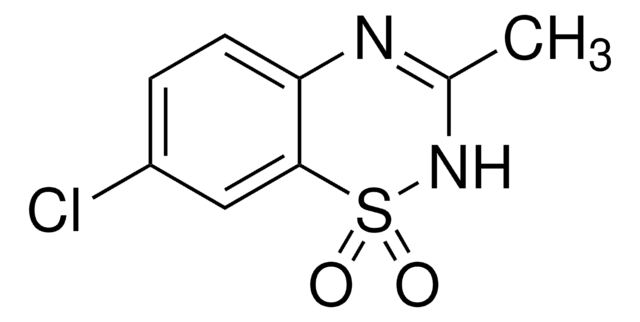SML0325
Retigabine
≥98% (HPLC)
Synonyme(s) :
D-23129, Ezogabine, N-(2-Amino-4-(4-fluorobenzylamino)phenyl)carbamic acid ethyl ester
About This Item
Produits recommandés
Pureté
≥98% (HPLC)
Forme
powder
Contrôle du médicament
USDEA Schedule V
Couleur
white to light brown
Solubilité
DMSO: >15 mg/mL
Température de stockage
room temp
Chaîne SMILES
FC1=CC=C(CNC2=CC(N)=C(NC(OCC)=O)C=C2)C=C1
InChI
1S/C16H18FN3O2/c1-2-22-16(21)20-15-8-7-13(9-14(15)18)19-10-11-3-5-12(17)6-4-11/h3-9,19H,2,10,18H2,1H3,(H,20,21)
Clé InChI
PCOBBVZJEWWZFR-UHFFFAOYSA-N
Informations sur le gène
human ... KCNQ1(3784) , KCNQ2(3785) , KCNQ3(3786) , KCNQ4(9132) , KCNQ5(56479)
Vous recherchez des produits similaires ? Visite Guide de comparaison des produits
Actions biochimiques/physiologiques
Mention d'avertissement
Danger
Mentions de danger
Conseils de prudence
Classification des risques
Acute Tox. 3 Inhalation - Acute Tox. 3 Oral - Aquatic Acute 1 - Aquatic Chronic 1
Code de la classe de stockage
6.1C - Combustible acute toxic Cat.3 / toxic compounds or compounds which causing chronic effects
Classe de danger pour l'eau (WGK)
WGK 3
Point d'éclair (°F)
Not applicable
Point d'éclair (°C)
Not applicable
Certificats d'analyse (COA)
Recherchez un Certificats d'analyse (COA) en saisissant le numéro de lot du produit. Les numéros de lot figurent sur l'étiquette du produit après les mots "Lot" ou "Batch".
Déjà en possession de ce produit ?
Retrouvez la documentation relative aux produits que vous avez récemment achetés dans la Bibliothèque de documents.
Les clients ont également consulté
Notre équipe de scientifiques dispose d'une expérience dans tous les secteurs de la recherche, notamment en sciences de la vie, science des matériaux, synthèse chimique, chromatographie, analyse et dans de nombreux autres domaines..
Contacter notre Service technique
















